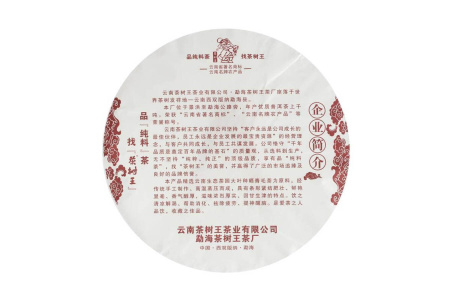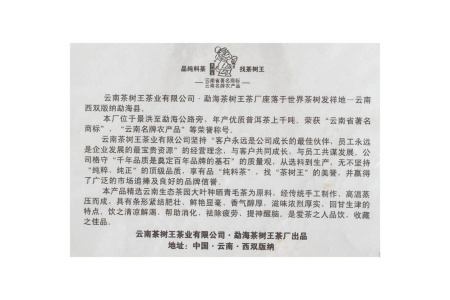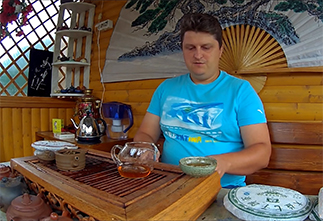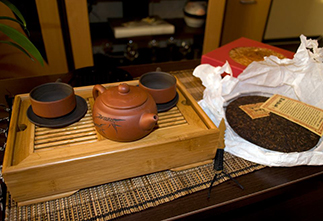-
0 Saturation
-
0 Aftertaste
-
0 Aroma
-
0 Effect
-
0 Balance
-
0 Body
Наименование пуэра «Пуюй» (кит. 璞玉, пиньинь púyù) переводится как «Необработанный драгоценный камень», также имеется второй более поэтичный вариант перевода «Ещё не признанный талант».
Производитель: Чайная компания Чашуван (Королевское чайное дерево), Юньнань (云南茶树王茶业有限公司, yúnnán cháshùwáng cháyè yǒuxiàn gōngsī).
The aroma when warmed by breath is restrained, calm, dryish, with woody notes.
After rinsing, a warm, clean, straightforward aroma is revealed with creamy woody notes and hints of toffee.
The brewed tea's flavor is soft, velvety, creamy, woody, and nutty, smoothing down the throat and pleasantly moisturizing. It fully unfolds after the third steep.
The aftertaste is melodic, sweetish with creamy and nutty nuances.
A gaiwan or Yixing clay teapot is suitable for brewing; the latter will bring out the best in the tea. The ratio is 8-10 grams of pu-erh tea per 100 ml of boiling water, using quick steeps.
This pu-erh has a good tonic effect, warms the whole body, gives strength, and concentrates attention.
It will be good for morning tea, since it is not brewed too strong and does not turn into “oil”.
|
Name in Chinese
|
璞玉 |
|
Pinyin
|
púyù |
|
Translation
|
Rough Gem (Unrecognized Talent) |
|
Country
|
China |
|
District
|
Xishuangbanna Dai Autonomous Prefecture |
|
Provinces
|
Yunnan (云南) |
|
Manufacturer
|
Чашуван (茶树王) |
|
Year of pressing
|
2018 |
|
Pressing form
|
Bing Cha (Cake Tea) |
- Reviews
- Vkontakte
Pu-erh is one of the most unique types of tea, which only gets better with age. Many people, when they first encounter this tea, wondered: why is pu-erh more often found in pressed form (cakes, bricks, tochas), and not in loose form? The reasons for this are related to both history and the practical aspects of storing and fermenting tea. Despite modern technologies that allow the production of loose pu-erh, the shape of pressed cakes remains unchanged. And pu-erh is more often found on sale in pressed form, for example, in the form of cakes or bricks, and loose pu-erh is less common. We will talk about the reasons for pressing pu-erh into cakes in this article.
Puer is a unique Chinese tea that is distinguished by its depth of taste, complexity of aromas and versatility of aftertaste. Its taste characteristics are formed under the influence of many factors, from growing conditions to the brewing method. Let's look at the main ones.
The question often arises: how to brew puerh correctly? Sometimes the phrase "to get high" is added to it. Moreover, everyone has their own understanding of this phrase. Some mean vigor, and some - intoxication. So how to brew puerh tea correctly? Let's consider several options.
Traveling through the tea mountains, we found ourselves in another land of blue roofs - the village of Zhongcai, which is located in the Menghai district of Yunnan province. According to tradition, we were shown another local tea tree, which, according to the Chinese, is at least a million years old :) The village is very authentic, not designed for tourists, there are many wild pu-erhs there and, of course, we were warmly received. They treated us to local cuisine and tea. We also asked the residents about the prices of tea and how they have changed in recent years.
The tea ceremony occupies a special place in the centuries-old Eastern tradition. And although the essence of this phenomenon remains constant, the nature and external manifestations of the tea ceremony in different nations have their own national characteristics. In each Chinese province, the tea ceremony and the tea used in it are varied: for example, residents of the southern provinces prefer green tea, and residents of the northern provinces - red tea, in Fujian province they more often use Oolong tea, and in Yunnan province Puer tea is widely known.




























































































